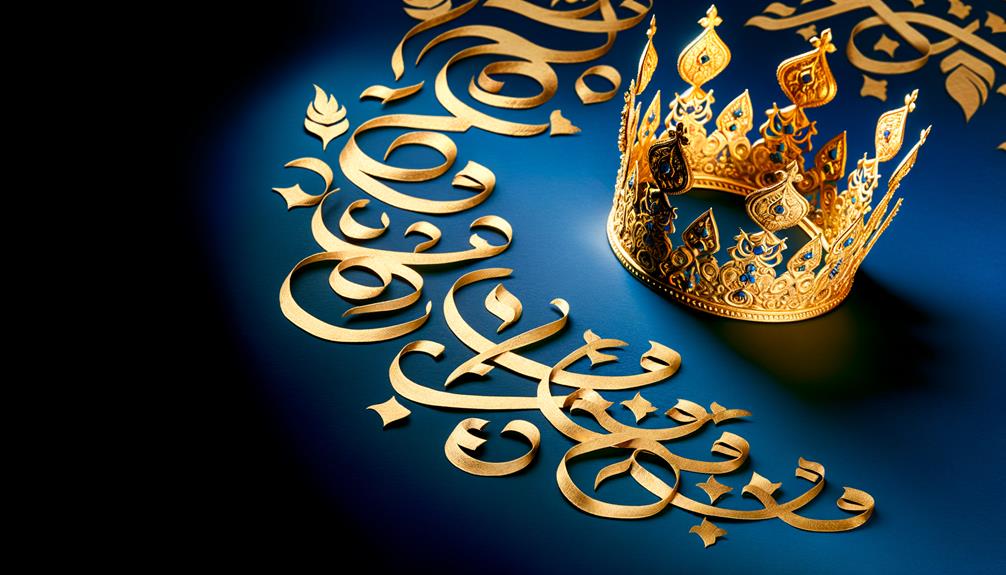Taj Name Meaning in English
The name 'Taj' originates from Persian and Arabic, meaning 'crown' or 'diadem.' It symbolizes authority, power, and nobility. In Persian culture, it represents royal insignia and highest achievements, while in Arabic, it conveys an exalted status and distinction.
Historically, it is linked to the grandeur of royalty, particularly during the Mughal Empire, as evidenced by the iconic Taj Mahal. In modern times, 'Taj' signifies luxury and cultural pride, resonating in various cultural settings.
Famous individuals named Taj include musician Taj Mahal and NBA player Taj Gibson. Continue to explore this name's rich cultural heritage and significance.

Key Takeaways
- 'Taj' means 'crown' or 'diadem' in Persian and Arabic.
- It symbolizes authority, power, and nobility in various cultures.
- The name is associated with historical and contemporary prestige.
- 'Taj' represents luxury, excellence, and cultural identity in modern times.
- Famous individuals named Taj exemplify excellence in diverse fields.
Origins of the Name
The name 'Taj' has its origins rooted in Persian and Arabic languages, where it translates to 'crown' or 'diadem.' This etymology reflects a deep historical context, as crowns have long symbolized authority, power, and nobility across various cultures.
In Persian, the word 'Taj' bears a direct association with royal insignia, often used metaphorically to signify the highest form of achievement or honor. Arabic usage similarly conveys notions of exalted status and distinction. The term has permeated various aspects of cultural and linguistic heritage, influencing names of landmarks, titles, and even personal names.
Understanding the etymology of 'Taj' provides a foundational insight into its widespread significance and enduring legacy in linguistic traditions.
Cultural Significance
The name 'Taj' carries significant cultural weight, particularly within historical and royal contexts where it has been synonymous with power and prestige.
In modern times, its symbolism extends beyond royalty, often representing excellence and high value in various fields.
This duality of historical reverence and contemporary admiration underscores the enduring impact of the name across different eras.
Historical and Royal Context
Rooted in historical and royal contexts, the name 'Taj' carries profound cultural significance, especially within Persian and Indian traditions. This name, meaning 'crown' or 'diadem,' evokes imagery of regal authority and grandeur. Its historical significance is underscored by several key aspects:
- Persian Influence: In Persian culture, 'Taj' has been associated with royalty and nobility, symbolizing the highest rank and honor.
- Mughal Empire: The name gained prominence in India during the Mughal era, exemplified by the Taj Mahal, a symbol of imperial grandeur.
- Architectural Significance: The use of 'Taj' in naming monumental structures underscores its association with splendor and power.
Thus, 'Taj' is intrinsically linked to historical prestige and cultural heritage.
Symbolism in Modern Times
In contemporary contexts, 'Taj' continues to symbolize prestige, elegance, and cultural identity across various societies. This enduring significance is evident in its use for prestigious establishments like hotels and brands, aiming to evoke a sense of luxury and excellence.
Additionally, 'Taj' maintains a strong connection to cultural heritage, particularly in South Asian communities, where it is often employed in names and artistic expressions to convey nobility. The term also resonates in popular culture, reinforcing its association with grandeur and distinction.
Therefore, 'Taj' remains a powerful symbol, bridging historical grandeur with modern aspirations of excellence and cultural pride, reflecting its multifaceted role in contemporary society.
Historical Context
Tracing the origins of the name 'Taj' reveals its deep-rooted significance in Persian and Arabic cultures, often symbolizing royalty and honor. Historically, the term 'Taj' has been associated with various royal emblems and titles, reflecting its importance in cultural and social hierarchies.
Notable historical contexts include:
- Persian Dynasties: The name 'Taj' was often used to denote crowns worn by Persian kings, signifying their divine right to rule and their elevated status.
- Islamic Architecture: The Taj Mahal, an iconic symbol of love and architectural grandeur, derives its name from this term, showcasing its cultural resonance.
- Literary Works: Historical texts and poetry frequently use 'Taj' metaphorically to describe supreme beauty and excellence.
These instances underscore the name's profound historical roots.
Linguistic Roots
Exploring the linguistic roots of the name 'Taj' reveals its etymological origins in Persian and Arabic languages, where it is commonly understood to mean 'crown.'
In Persian, 'Taj' (تاج) has been historically used to signify royalty, often associated with regality and power. Similarly, in Arabic, the term 'Tāj' (تاج) denotes a headpiece symbolizing authority and nobility.
This cross-cultural usage underscores the name's deep-rooted significance across different societies. The name's phonetic simplicity belies its rich connotation, encapsulating an image of dignity and high status.
Famous People Named Taj
The name Taj has been borne by several notable individuals, both historically and in contemporary times. Among historical figures, it has been associated with royalty and leaders, while in modern contexts, it is seen among prominent celebrities in various fields.
This section will explore the significance of the name through the lens of these influential personalities.
Notable Historical Figures
Throughout history, several prominent individuals named Taj have made significant contributions to various fields, from politics to the arts. These figures have left an indelible mark through their exceptional achievements:
- Taj al-Din al-Subki – A distinguished 14th-century Islamic scholar, known for his extensive writings on theology and jurisprudence, Taj al-Din al-Subki played an essential role in shaping Islamic thought during his era.
- Taj Mahal – Although primarily known as a mausoleum in India, the name also refers to the Mughal emperor Shah Jahan's beloved wife, Mumtaz Mahal. Her legacy lives on through the architectural marvel named in her honor.
- Taj al-Saltana – An influential Persian princess and memoirist in the 19th century, Taj al-Saltana was a pioneering advocate for women's rights and education in Iran.
These historical figures exemplify the diverse impact of individuals named Taj.
Contemporary Celebrities
In contemporary culture, several individuals named Taj have risen to prominence across various sectors, including entertainment, sports, and business.
Taj Mahal, an American blues musician, stands out with his contributions to music, blending various genres and influencing generations.
In sports, Taj Gibson has made significant strides as a professional basketball player in the NBA, known for his defensive prowess and leadership qualities.
Additionally, Taj Burrow, an accomplished surfer from Australia, has made waves in the surfing world with numerous accolades.
In the business domain, Taj Eldridge is a notable venture capitalist focused on clean technology and sustainability.
These individuals not only share the name Taj but also exemplify excellence and influence in their respective fields.
Popularity Over Time
Over the past few decades, the name Taj has seen varying levels of popularity, influenced by cultural trends and notable figures. This fluctuating interest can be attributed to several factors:
- Media Exposure: The name has occasionally surged in popularity due to its use by high-profile individuals in entertainment and sports, which increases its visibility.
- Cultural Shifts: Changes in societal values and multicultural appreciation have also played a role, as names with diverse origins gain wider acceptance.
- Historical Resonance: The name's association with historical monuments, such as the Taj Mahal, adds a layer of timeless appeal, influencing parental choices.
These factors collectively illustrate the dynamic nature of Taj's popularity over time, reflecting broader cultural and societal trends.
Modern Interpretations
Building on the historical and cultural factors affecting its popularity, modern interpretations of the name Taj reflect a blend of contemporary values and global influences.
In today's multicultural landscape, the name Taj is often associated with qualities such as regal elegance and cultural sophistication, drawing from its Persian and Arabic roots meaning 'crown.'
Additionally, the name has found resonance in various artistic and intellectual communities, symbolizing creativity and a global outlook.
With increased cultural exchange, Taj has garnered appeal beyond its traditional regions, making it a versatile choice in a globalized world.
This modern perspective highlights the name's ability to transcend cultural boundaries while retaining its rich historical connotations.
Choosing Taj as a Name
Selecting the name Taj involves a consideration of its historical significance, cultural resonance, and modern appeal. Derived from Persian, where it means 'crown,' the name carries a regal connotation that has persisted through centuries.
In choosing Taj, one should evaluate several key factors:
- Historical Context: Taj has a rich background, often associated with royalty and grandeur, particularly exemplified by the Taj Mahal.
- Cultural Significance: The name holds substantial weight in various cultures, especially in South Asia and the Middle East, where it is imbued with symbolic importance.
- Modern Relevance: Despite its historical roots, Taj remains a contemporary and unique choice, blending seamlessly into diverse cultural settings.
Conclusion
Much like the intricate carvings of the Taj Mahal that stand timeless against the sands of time, the name Taj weaves a rich tapestry through history and culture.
Its roots, deeply entrenched in language and tradition, echo a legacy of grandeur and significance.
As the name continues to traverse through modernity, it carries with it the weight of its illustrious past, offering a beacon of identity and heritage for future generations.






